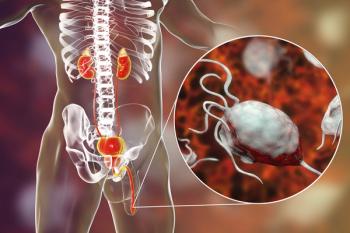
Post-Op Radiotherapy May Benefit Prostate Cancer Patients
Radiotherapy directly after a prostatectomy in prostate cancer patients has long-term benefits, says a 10-year study. The study shows that radiation can prevent biochemical progression, as measured by rising prostate-specific antigen (PSA) levels.
Radiotherapy directly after a prostatectomy has long-term benefits for prostate cancer patients, according to a study
A 10-year follow-up of this study shows that radiation therapy immediately following surgery may benefit prostate cancer patients
“There is a significant improvement in local control and biochemical disease-free survival,” said lead author Michel Bolla, MD, Department of Radiation Oncology, Centre Hospitalier Universitaire A Michallon in Grenoble, France.
These long-term results reassure the continued benefit and safety of radiation after surgery in prostate cancer patients with locally advanced or high-risk disease, said Bolla. Younger patients and those who had positive surgical margins after surgery are most likely to benefit. “Patients less than 70 have a trend in improvement in disease-free survival,” said Bolla.
“Importantly, the patients who received radiotherapy were less likely to receive hormonal therapy later in their course of treatment for progressive disease,” said Jason A. Efstathiou, MD, Department of Radiation Oncology at Massachusetts General Hospital and Harvard Medical School in Boston. “Hormonal therapy is used for recurrent prostate cancer, is often used indefinitely, and has many associated toxicities. Avoiding the need for hormonal therapy is an important finding, in my opinion.” Efstathiou is the author of the
The 5-year follow-up data for this trial,
The significant difference in clinical progression-free survival seen at the 5-year time point did not translate to the 10-year time point (hazard ratio = 0.81). Radiotherapy was also not found to have an effect on the 10-year rates of cancer spread or on overall survival.
The Study Design and Results
The trial recruited 1,005 patients with high-risk prostate cancer and randomized them 1:1 to either radiotherapy or watchful waiting. Specifically, patients had pathologic T2–T3 disease and extracapsular extension, seminal vesicle invasion, or positive surgical margins. The patients were followed for a median of 10.6 years to understand the effects of radiotherapy within 4 months post-prostatectomy. The trial started in 1992 and was fully accrued by 2001.
Radiotherapy after surgery resulted in a significant improvement in biochemical progression-free survival compared to watchful waiting (hazard ratio = 0.49, P < .0001). The radiation-therapy treated patients had better local disease control (hazard ratio = 0.45) and were more likely to need follow-up hormonal therapy.
Late-developing adverse effects were generally more frequent in patients who received radiation therapy-the cumulative incidence of these adverse events was 70% in the radiation group compared to 59% in the untreated group (P = .001).
“Patients with a negative PSA value after surgery, who are at risk, but who are reluctant to receive immediate radiotherapy to maintain their sexual health, or because of comorbidity, may be followed clinically and biologically,” said Bolla. “With the very sensitive PSA tests we have now, biochemical relapse may be diagnosed [earlier] and salvage radiotherapy may start earlier.”
Efstathiou, in his editorial and in an interview with Cancer Network, highlighted the differences in both distant metastases and overall survival outcomes between the current EORTC trial and the US-based SWOG 8794 trial. The SWOG 8794 trial, unlike the EORTC trial did show an increased overall survival for those men given radiation therapy postsurgery. According to Efstathiou, several reasons can explain the different results including an increased use of salvage radiation therapy in the EORTC study compared to the SWOG study, a significantly higher rate of distant metastases in the observational arm of the SWOG study, and a high numbers of non–cancer-related deaths due to other or unknown causes in the irradiation group in the EORTC study. “All of those differences probably explain why the two studies differed in results,” said Efstathiou.
While the trials are not perfect, the results of the 10-year EORTC trial “support the use of postoperative irradiation in patients younger than 70 years and those with positive margins,” said Efstathiou in the editorial.
More men tend to receive radiotherapy postsurgery, according to Bolla. Generally, patients who are classified as “pT3 with a perforation of the capsule or an involvement of seminal vesicles with or without a positive margins have to be irradiated as specified in the European Association of Urology guidelines,” said Bolla. “For patients pT2 R1 with an intracapsular disease but a positive margin, postoperative irradiation remains controversial,” added Bolla.
A main unresolved question, according to Efstathiou, is whether all patients should receive adjuvant therapy or whether salvage radiation therapy should be reserved for patients who recur with a PSA failure. “This debate is not fully informed by these [two] trials. The optimal timing of postoperative radiation is still an ongoing question,” said Efstathiou, who added that based on available data, earlier use of salvage radiation, when a patient still has a relatively low PSA level, results in better outcomes.
The best timing for postoperative radiation is currently being addressed by several ongoing trials aimed at resolving this issue: Radiotherapy and Androgen Deprivation In Combination After Local Surgery–Hormone Duration (RADICALS-HD), the Radiotherapy Adjuvant Versus Early Salvage (RAVES), and Groupe d'Etude des Tumeurs Uro-Gnitales (GETUG)-17.
Based on data available today, Efstathiou believes the decision whether to treat men postsurgery should be made by the patient’s multidisciplinary team of surgical, radiation, and medical oncologists based on all of the evidence available.
Newsletter
Stay up to date on recent advances in the multidisciplinary approach to cancer.


















































































